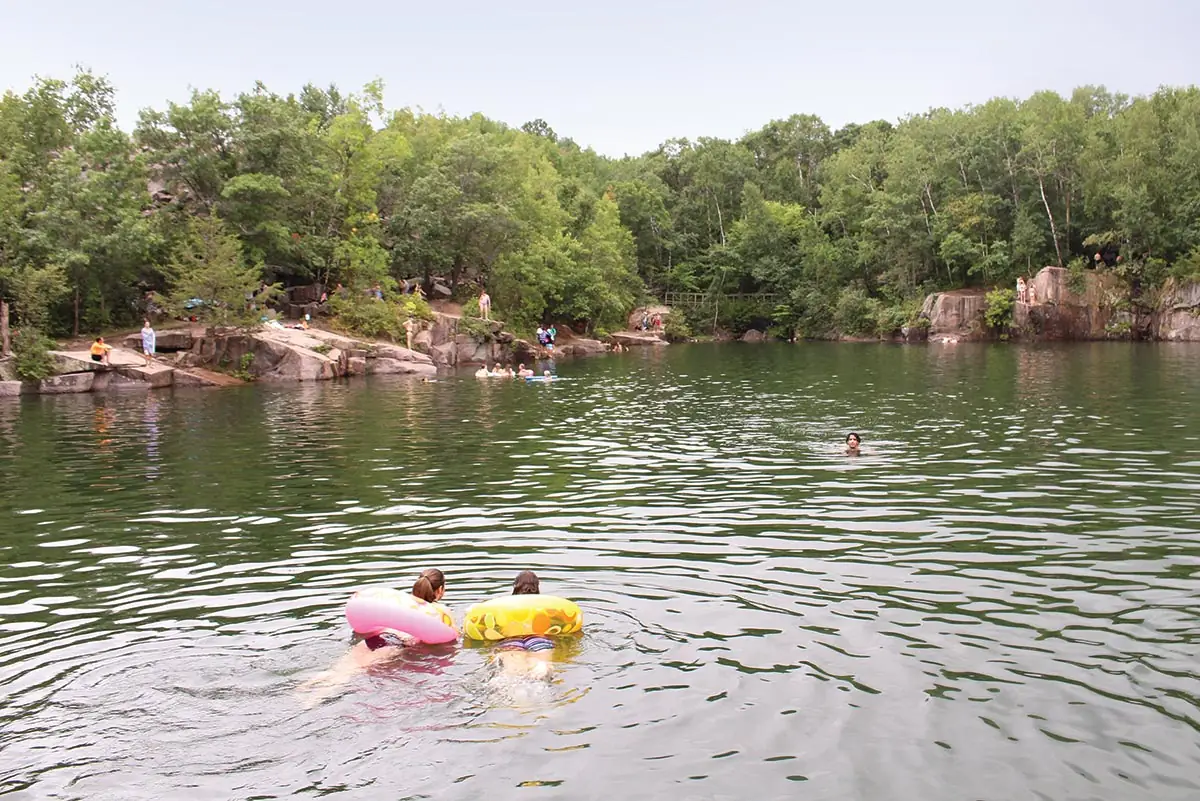At first glance, stone quarrying appears to be a messy business. Great mounds of earth are excavated and massive blocks of limestone, marble, sandstone, and nearly every other type of stone under the sun are carved and carted off for dressing and further finishing. But, once all that dust settles, the harvest and use of natural stone is an environmentally low-impact proposition when compared to manufacturing building materials like concrete and steel, among others, owing to fewer steps in transportation and production. Quarriers and fabricators, both stateside and around the world, are implementing additional practices and strategies to reduce their environmental impact even more.

Image © Natural Stone Institute, click to enlarge.
The Natural Stone Institute’s Sustainability Standard (ANSI/NSI 373), released in 2014 but strengthened by four significant updates in the succeeding years, has emerged as the industry benchmark for environmentally sound stone quarrying and production processes in the United States. The multi-attribute standard considers numerous factors, ranging from environmental responsibility and adaptive reuse of spent quarries to the management of excess materials and waste, including recycled water from the cutting process. “In most cases, the sustainable choice is also the most efficient, ultimately leading to cost savings,” notes Natural Stone Institute marketing director Sarah Gregg. “Our biggest hurdle is awareness among the design community. If more specifiers required stone to be sourced from certified-sustainable quarries it would impel more quarriers to apply to have the ANSI/NSI 373 standard.”
Coldspring, a 125-year-old quarrier with 30 sites and several production facilities across North America, has long practiced sustainably, having been a driving force in the development of the Natural Stone Institute industry standards. On the ground, such policies work on numerous fronts. According to Reid Kubesh, Coldspring vice president of sales for stone products, stone producers can start by investing in more efficient saws and wedging units, which reduces processing times and, in turn, emissions and material waste. Another of Coldspring’s strategies involves reusing its leftover grout and debris for other purposes: crushed for use in decorative landscaping or roadbeds, as riprap in jetties or shoreline-restoration projects, and as railroad ballast.
When a quarry is exhausted—a process that can take decades, if not centuries—it is often abandoned, with industrial detritus and material waste left to litter the pit lakes that later form in them. But pressure is mounting for quarries to adopt more responsible approaches, as formalized by the ANSI/NSI 373 guidelines, including adaptive reuse and renaturalization.
In Minnesota, Coldspring played an integral role in the creation of the Quarry Park and Nature Preserve, a 684-acre public park that reimagines spent quarries as rock-climbing walls and swimming holes surrounded by hiking trails and mountain bike paths. Farther afield, in Germany, 50-year-old quarrier Franken-Schotter also leads in this area. The company has renaturalized the 30-acre decommissioned Möhren Quarry and a 65-acre section of the active Deitfurt Quarry, both in Bavaria, in collaboration with local authorities. “We have a responsibility to people who live in proximity to our quarries,” says Franken-Schotter architectural consultant Jonah Wurzer-Kinsler. “It has been incredible to see the return of biodiversity to such sites, including Eurasian eagle-owls, which were thought to be extinct in the region,” he adds.

Quarry Park swimming hole. Photo © Coldspring
Vermont Quarries, a subsidiary of the Italian conglomerate RED Graniti, operates the largest underground marble quarry in the world, in Dorset Mountain, within the Taconic Range, approximately one-and-a-half miles belowground. Their production facility, also located within the mountain, can produce up to 4,000 square feet of marble slabs daily. According to quarry manager Keith Millard, approximately 1,500 gallons of water are consumed each minute to cool and remove slurry from their various cutting machines.

Vermont Quarries’ underground operations. Photo © Vermont Quarries
The company, instead of relying on local water mains, utilizes the approximately 10 million gallons of water that naturally collect at the bottom of the quarry, siphoning it to the facility above. After use, the wastewater is transferred to four settlement ponds, where, over time, its lime-based sediment filters down, and the water slowly returns to the bottom of the quarry. When dry, the lime is extracted and applied as fertilizer to the surrounding hillsides. Scrap or crushed marble is also used to line stone ditches and build roads, and to tip marble blocks.
In another step toward heightened sustainability, quarries and production facilities are increasingly deploying renewable energy to power their operations. For example, Spanish quarrier and sintered-stone fabricator Cosentino, as of 2022, has operated a 120-acre solar farm at their Almeria headquarters that, coupled with rooftop installations, supplies some 30 percent of the plant’s total energy demand—comprising the country’s largest photovoltaic array harnessed for self-consumption.
By implementing sustainable practices like these, quarriers and facility operators can earn a grade of certification, not unlike the LEED rating system, and that information can be used for environmental-product declarations. Architects eager to reduce the environmental footprint of their projects can, in turn, work with responsible quarriers and specify lower-impact materials. There isn’t a panacea to reduce greenhouse-gas emissions and pollution within the building-materials industry, but growing adherence to sustainable norms by stone quarriers and producers could provide something of a road map going forward.





